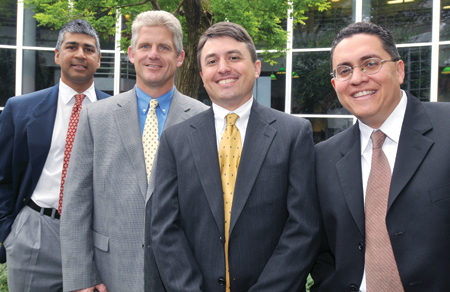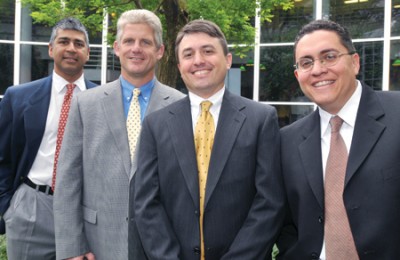 They are among the nation’s most compelling potential customers— the nearly 100,000 men, women and children who are in line for the fewer than 30,000 organ transplants that will be performed this year. That staggering gap is caused both by a scarcity of donors and by the fact that only 70 to 80 percent of the organs actually harvested can be utilized because of problems with quality or preservation.
They are among the nation’s most compelling potential customers— the nearly 100,000 men, women and children who are in line for the fewer than 30,000 organ transplants that will be performed this year. That staggering gap is caused both by a scarcity of donors and by the fact that only 70 to 80 percent of the organs actually harvested can be utilized because of problems with quality or preservation.
The work of four members of the Vanderbilt Executive MBA Class of 2008 may help change the latter half of that equation. Their start-up proposal, developed for an Owen classroom and aimed at bringing to market a system that would better preserve donated organs, has earned the top prize in a prestigious business competition and has begun moving them toward the marketplace.
Classroom Origins
The company, Organ Transplant Technology (OTT), began attracting real-world interest while it was still a project in Bruce Lynskey’s entrepreneurial course, Creating and Launching the Venture, during Owen’s fall 2007 semester.
“In seven years of teaching at Owen,” says Professor Lynskey, himself a successful entrepreneur, “I can count on one hand the number of classroom projects I’ve seen with this much potential upside.”
Three panels of judges agreed with him. The OTT proposal wowed a group of venture capitalists brought in by Lynskey to rate student projects, reached the semifinals of the Wharton Business Plan Competition, then took top prize in the MBA Jungle Business Plan Competition in New York. For the team that developed and pitched the idea—Dr. Ravi Chari, Ted Klee, Drew Bordas and Fernando Sanchez—those milestones served as validation of both the quality of their teamwork and the importance of the concept itself.
We realized this was more than just a classroom project or a competition. This is something that can really save people’s lives.
~ Fernando Sanchez
“We realized this was more than just a classroom project or a competition,” says Sanchez, who is Vice President of Finance and Treasurer of Gibson Guitar Corp.
“This is something that can really save people’s lives.”
The project is the culmination of two years of teamwork for Sanchez; Klee, who is Vice President of Square D/Schneider Electric Co.; Bordas, Director of Warehouse Management Systems for Ingram Book; and Chari, Professor of Surgery and Cancer Biology and Division Chief of Hepatobiliary Surgery and Liver Transplantation at Vanderbilt University Medical Center. The four were assigned to the team by Associate Dean of Executive Programs Tami Fassinger, who cites their disparate backgrounds as a source of strength.
“The goal of the study groups is to approximate all the skills you’d have in the executive suite,” she says, “and with this group you’ve got people representing four areas of functional experience as well as four different industries. Fernando Sanchez comes from the world of musical instruments and played the role of finance guy. You’ve got Ted Klee, who is the quintessential engineer and who understands manufacturing and operations. You have Drew Bordas, who understands distribution from a service industry point of view and has got the consumer piece. And then Ravi is the doctor at a leading medical center, bringing the scientific piece and contacts in the health industry.”
The quartet clicked at the week-in-residence at New Harmony, Ind., a getaway that kicks off the Vanderbilt Executive MBA experience, developing a style that was part think tank, part frat house.

“They’re big practical jokers and very sarcastic,” says Fassinger, “but they genuinely enjoy each other’s company and have become very good friends. It was just that typical guy thing—making fun of each other, but out of respect. It was about all four of them getting the idea right.”
A Better Solution
They used first-year projects to hone their group approach, then weighed ideas for Lynskey’s class during the summer between academic years. The one they chose grew out of Dr. Chari’s work as head of Vanderbilt Medical Center’s liver transplant surgery team.
“Currently,” says Dr. Chari, “of the 40,000 to 50,000 potential donors, more than half are excluded because of concerns with organ preservation and quality. Of those that are harvested, 20 to 30 percent are not actually used, again because of concerns about preservation and quality. It is critical that organs are optimally recovered and stored.” That led him to the work of a European friend who was “having trouble commercializing a project that from a scientific standpoint had a lot of merit.”
The project took aim at improving the decidedly low-tech means now in use for transporting donated organs, which are placed in a solution in a zipped plastic bag and carried on ice in a portable cooler. That technique risks damage to the organ through freezing or temperature variation, and greatly limits the sustained viability of a donated organ. At present the limits are six hours for a heart, 12 for a lung or liver, and 24 to 30 for a kidney. Work done in part by Dr. Thomas Van Gulik of the University of Amsterdam brings two improvements to the process. The first is a system driven by compressed air that circulates the solution through the organ, constantly supplying it with oxygen and nutrients designed to prolong its useful life. The second is an improvement in the perfusion solution itself. Both can be used in an easily portable container that keeps the organ at a stable low temperature.
In addition, one of Dr. Chari’s colleagues at Vanderbilt, medical student Clayton Knox, had developed and patented with Dr. Chari a compound designed to improve the performance of the perfusion solution even further.
The others embraced Dr. Chari’s proposal enthusiastically.
“Ravi’s idea surfaced pretty quickly because it was real,” says Bordas. “It was no contest, really.”
Bordas, Klee and Sanchez all acknowledge the centrality of Dr. Chari’s role and the importance of his technical knowledge and contacts, but Dr. Chari himself is quick to return credit.
“From a logistics standpoint,” he says, “Drew is outstanding. Ted is all over the strategy and the operations side, and Fernando is great with the financial side, so each brought different areas and perspectives. A good thing about them is that they aren’t in the medical field, and they brought a real business perspective and asked demanding questions: ‘The science is good, but how can we monetize the idea so that it’s something people would actually buy?’ They pressed those issues further than a roomful of my colleagues would, and so we were able to turn a great idea into a marketable business plan people would be interested in.”
The strength of the team and its presentation was clear by late November, when Lynskey had his students present a working draft of the proposal, weeks before their final presentation.
They submitted their draft, and I brought it home and read it again and again, looking for something I could say was wrong with it. My only comment back to them was, “You need a nice presentation cover for this.” I’d never seen anything like it.
~ Professor Bruce Lynskey
“Ravi’s team submitted its draft, and I brought it home and read it again and again, looking for something I could say was wrong with it,” says Lynskey, “and my only comment back to them was, ‘You need a nice presentation cover for this.’ I’d never seen anything like it.”
By the time of the in-class, end-of-semester presentation to a six-member panel of venture capitalists, the team’s message had been finely honed. Each panelist had $5 million dollars in imaginary money to distribute among 10 team proposals, and OTT garnered about two-thirds of the $30 million available.
“As they started talking about our proposal,” says Sanchez, “I turned to Ravi and said, ‘You’d better give them your business card. This thing has legs.’”
From Competition to Market
The team had already entered the Wharton Business Plan Competition, which requires that one member of the team be pursuing a Wharton MBA. That was exactly what Knox, who was still working toward his M.D. at Vanderbilt, was doing, following in the footsteps of his mentor, Dr. Chari.
“I realized,” Knox says, “that in academia, there are all these great minds and great ideas, but not a lot of people know how to get them out of the lab. Scientists are much better at thinking up new ideas than commercializing them.”
Professor Lynskey’s course had guided them toward doing just that.
“We never would have gotten this far had we not been in a program that forced us to think the project through and commit it to paper,” says Klee. “And I don’t think any of the guys in the group ever would think about doing something like this on his own, but put us together as a group, each with our own sets of talent and experience, with the university training us around these aspects important to developing a business plan, and it’s not that long of a putt.”
Their success continued as they were named semifinalists in the Wharton competition.
“When that announcement came out,” says Bordas, “The Wall Street Journal piece cited five ideas and ours was one of the five. Some of the judges said it was the best paper they’d seen in five years, and we said, ‘We should think about this more seriously.’”
They had entered the Jungle competition at the urging of Professor Lynskey. Their win capped an incredible run for what had begun as a classroom project and convinced them to pursue the company’s future, beginning with a return visit to Lynskey.
“The great thing about Bruce,” says Bordas, “is that he’s been there and done that. When you have a guy teaching you about starting companies who has started them and been very successful at it, that just gives the whole course a ton of credibility. And when we went back to him and said, ‘This looks real. What should we really do next?,’ he was able to have that dialogue with us. That’s one of the things you get by going to a university like Vanderbilt.”
The team has never lost sight of the underlying importance of the endeavor.
“More and more often, less-than-ideal organs are used, which is an unfortunate but necessary practice to manage the long waiting list,” they write in their business plan. “Ultimately, OTT’s goal is to improve the size and quality of the organ pool available for transplantation in order to increase the number of transplants performed each year and reduce the organ waitlist.”
“It’s pretty clear,” adds Dr. Chari, “that we’re excited about moving ahead with this work and with ironing out the agreements we need to get under way.” To that end, they are working to effect an agreement with the Amsterdam-based developer of the solution and the air-drive system, while awaiting approval of both in the United States and the chance to deliver the concept to a waiting marketplace.
“Some of the significant liver transport units around the country are eager to get it and put it into trials,” says Klee.
A Rewarding Experience
The value of the team’s Owen experience has become more apparent, with Dr. Chari seeing his MBA as a key to better positioning in a changing medical climate.
“Looking at the landscape of health care right now,” he says, “a premium is being placed on improved processes and improved function in the medical field. Traditional medical education gears you toward science and clinical applications for patients, but cost efficiency, process efficiency and other business principles constitute an important language to be able to speak.”
His Owen experience, he says, “changed not only how I think but how I analyze a situation—not just what information to use, but what questions to ask and where to look for that information.”
For Knox, who is part of OTT’s management team, the project’s success is “extremely rewarding and extremely validating in terms of the need for people who can understand both worlds, who can understand medicine and the business side of it—something Vanderbilt is especially good at fostering.”
As noble as the medical aims of OTT are, its principals are equally thrilled with the personal rewards of their Owen experience.
“We had a great class,” says Bordas. “Meeting those 40 or 50 people, I think, is going to pay dividends down the road. And within our group, I’m very grateful to have that core set of people you can bounce things off of. I consider them very good friends as well as mentors.”
Those friendships are likewise a prime reward for Sanchez.
“First and foremost,” he says, “I now have three or four people who I consider great friends for life. They are just good people from varying backgrounds, and I wouldn’t have met them any other way.
“The experience,” he says, “is a great one from a personal standpoint.”

Comments
2 responses to “Organic Chemistry”
Wonderful story. Thanks muchly.
As a Vandy alum (BE 1994) I am very pleased to see the development of this project. I had a kidney transplant in 1993, and have recently returned to dialysis while I await a second transplant. A little known fact among the general public is that transplants do not typically last a lifetime. With the population in this country aging and rates of high blood pressure and diabetes increasing, the wait list for transplantation will continue to increase. The list of those that are waiting has increased by over 15000 in the time that I have been waiting myself. Innovative technologies and new ideas must be applied if this situation it ever to be improved. Best regards and best wishes for success with this project!